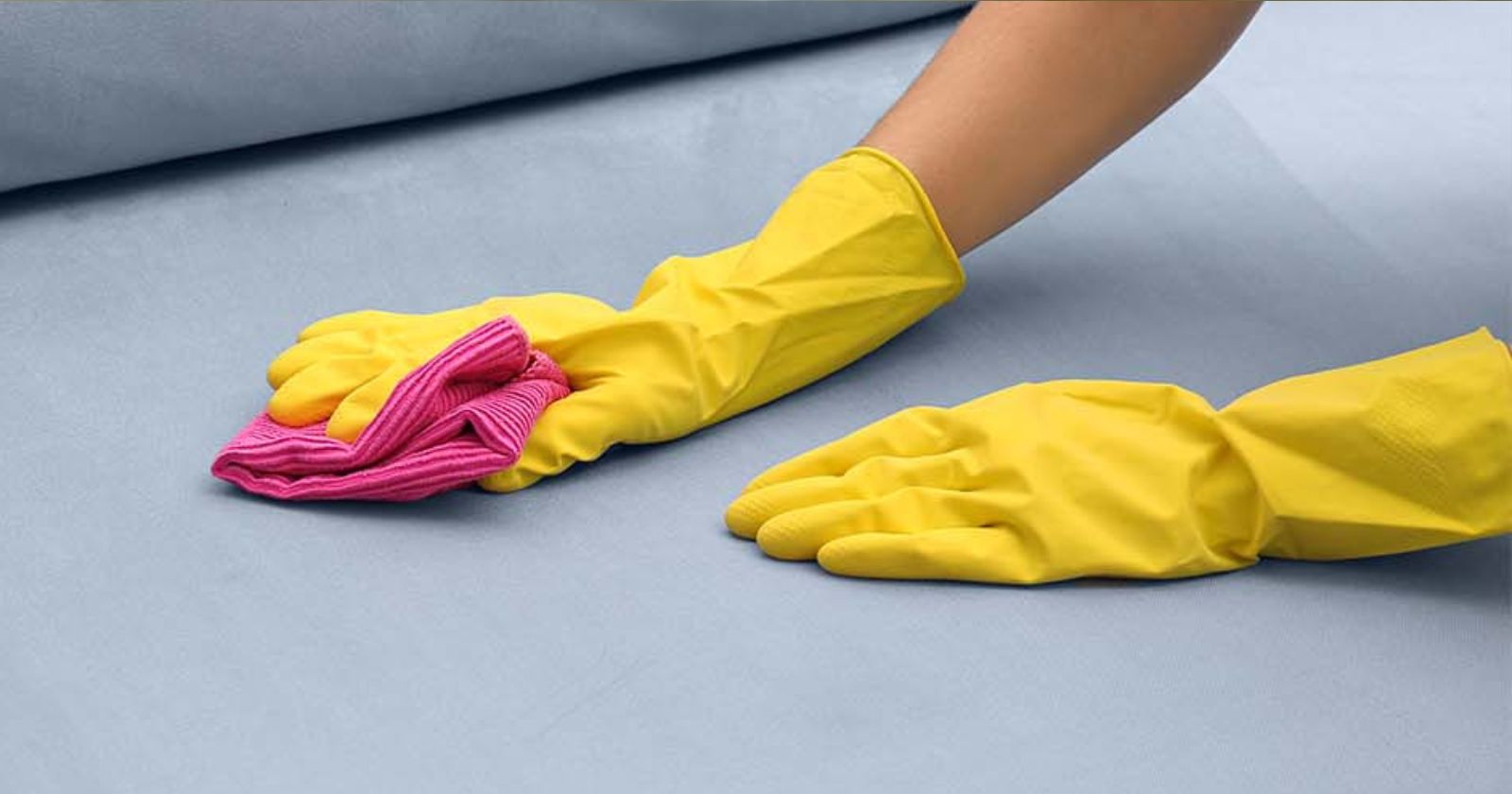Like all household items that get a lot of wear, your couch can easily look tired and grubby. Sticky fingers, spills, pet hair and regular grime can leave your couch looking very sorry indeed.
But there’s no need to hunt for a brand new couch just yet! By giving this vital piece of home furniture a good clean, you’ll be amazed at how you can revitalize your whole room and add years to your couch’s lifespan.
Let’s look at how to clean a couch so that it looks as good as new.
What Do Your Upholstery Cleaning Codes Mean?
Before you begin looking at how to clean a couch, make sure that you’re familiar with the material that’s been used to upholster it. After all, you wouldn’t use leather conditioner on a velvet couch, so familiarize yourself with the cleaning codes found on your manufacturer label.
The code for your couch will likely be underneath or at the back of your couch, and will display, along with the fire code, one of the following: W, S, S-W, X, DC or F. These relate to the washing instructions for your couch. Let’s take a closer look at what each of these codes mean:
- W stands for Wet cleaning. It means that the products that you use on your couch cushions must be water-based. With this couch code, you can safely dilute fabric detergents or similar products with water, and even use a steam cleaner. Chemicals such as rubbing alcohol should be avoided.
- S stands for Solvent cleaning. This type of couch will show up water stains and so can’t be cleaned with water. Instead, use only a water-free solvent or a dry-cleaning product. Solvents can be toxic in closed rooms though, so be sure to well ventilate the room when using them.
- S-W stands for Solvent-Wet cleaning. It can be somewhat of a confusing code because it seems to give conflicting advice, but it means that the fabric upholstery can take both water-based cleaning products and dry cleaning solvents. It can also mean that different parts of the couch should be cleaned in different ways. If you’re in any doubt, spot clean only and call the manufacturer for clarification.
- X stands for No Products. If you have an X code, your couch fabric is too delicate for any kind of cleaning products and should only be brushed, or lightly vacuumed.
- DC stands for Dry-Clean only. This is similar to the S, or solvent, code, and means that no water-based products should be used.
- F stands for Foam cleaning. It’s a rare code to find but some couch fabrics can only be cleaned with a mild cleaning agent that, when applied, becomes a foam.
How to Clean a Couch (Regular Cleaning)
You can save yourself a huge cleaning job once a year by keeping up to date with light couch maintenance. When it comes to knowing how to clean a couch, the trick is that little and often is always better. We recommend you follow the cleaning tips below once a week to keep your couch in good condition.
Cleaning an Upholstered Couch
Take your vacuum cleaner and use a light setting and preferably an upholstery attachment and go over the couch, including along the back and the arms. Take off all of the cushions and vacuum up crumbs, dirt, and pieces of food that have slipped down under the cushions.
A regular vacuuming removes not just crumbs and dirt but germs that rest on the surface of the fabric, particularly if you regularly have your pet on the couch, too.
Cushion covers can be removed and taken outside to be shaken or beaten over a washing line to remove more ingrained dirt. Some cushion covers can even be put in the washing machine if they’re made of a more durable fabric but you must always check the label to make sure this is an option. However, many people prefer not to put their covers in the washing machine because they find they can’t get the right shape back again afterwards.
For small stains on the sofa, use distilled water mixed with a water-based cleaning solution and put into a spray bottle. Spray the solution lightly onto the fabric and dab the area with a cloth. Never rub the cleaning solution into the couch, as it can only stain the area further. Instead, always dab lightly.
If your couch label specifies a solvents-only cleaning process, first ventilate your living room and then apply the dry-cleaning solvent to the area you want to clean. Gently work the stain out with an upholstery brush.
Take away excess moisture with a dry cloth lightly pressed on the fabric, and then leave the couch to air dry. If cleaning a stain on a cushion, don’t put it back on the sofa until it’s dry.
Cleaning a Leather Couch
While leather makes for a more expensive material, it’s so much easier to keep clean and is often the fabric of choice for those with allergies to dust because it doesn’t hold dust and dirt the same way upholstery couches do.
Once again, vacuum first to get off all your pet hair, crumbs from the toast the kids ate earlier, and germs. Many vacuum cleaners come with more than one brush attachment to choose from.
Then, it’s as easy as wiping down the couch with a microfiber cloth or even antibacterial wipes, which are a great way to keep your leather couch protected against bacteria.
To get rid of marks and stains, you can begin to introduce soft cleaning products, starting with regular dish soap and water, dabbed into the marks with a cloth. If the dish soap doesn’t do the trick, then try a 50/50 solution of a cup warm water mixed with a cup vinegar as an effective yet still gentle cleaner.
If there’s grease on the leather, make a solution of warm water and baking soda. Baking soda has active agents that lift dirt from all manner of materials without damaging them.
If you’re not sure about whether your cleaners will damage your furniture, first do a spot test in a small area that’s not usually on show, such as the back of the couch. Wait to see the results before you apply the product to the rest of the couch.
Cleaning an X-Code Couch
If your couch is marked as an X for cleaning products, then don’t use any products on the piece of furniture, including water, which can stain.
Instead, lightly vacuum the couch and cushions only, using the correct brush attachment.
How to Deep Clean a Couch
Sometimes, the regular light cleaning just won’t do. Maybe the kids have had an accident on the couch, or you’ve got something tough like blood on it (click here for our guide for cleaning blood off upholstery), or maybe you’ve bought a second-hand sofa but want to give it a thorough cleaning once you get it home.
In that case, deep cleaning is the answer, and the best method of deep cleaning your couch is to use a steam cleaner. The beauty of steam cleaners is that it’s not so much the detergent or chemical used, but the steam itself. High heat kills bacteria, tackles odors, and lifts stains.
A good handheld steamer will work well without any added products but if the stains or odors are more stubborn, add an approved steam cleaning upholstery cleaner, and be sure to read the instructions on the back of the bottle and spot test as normal (always check steam cleaning is appropriate for your fabric before proceeding).
Odors can also be treated with a sprinkling of baking soda over the cushions, which is left for a while, and then vacuumed away.
How to Remove Stains From a Couch
Stains on your couch are an unfortunate occurrence from time to time, whether from glasses of red wine slipping out of hands or the occasional spill of coffee. Don’t worry, though: acting fast is the key. A dry cloth immediately dabbed on the area will soak up much of the offending product.
Cleaning your couch of tougher stains depends on the type of fabric your sofa is made of, so once again go back to the label.
For fabrics that can take water-based products, it’s not always necessary to use a commercial upholstery cleaner. Here’s where your cup water/cup vinegar solution in a spray bottle will be your best friend.
Spray, dab, and repeat the process until the stain has lifted. It may take several applications to get rid of the stain completely, so if your pure white sofa just won’t recover from the red wine spill, call a professional cleaner to your home. Their whole job is couches, and they’ll know what to do!
Grease stains can be dried out and lifted using baking soda, and this applies to both fabric and leather couches in your home. For a biro mark on a leather sofa, a small amount of rubbing alcohol applied with a Q-tip can lift the ink, but it can also dry out the leather, so be sure to treat the leather of your couch with some good-quality leather furniture cream afterwards.
Conclusion
Good couch care can mean the most-used item in the home will last much longer than expected! By following the instructions carefully and being sure to use the right products for your couch, you’ll find that the family sofa will look and smell great.


